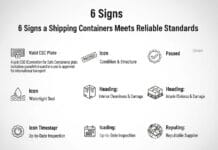When you’re sourcing products from China, understanding shipping timelines is crucial for your business planning. Chinese exports follow specific patterns that can significantly impact when your goods arrive at their destination. From factory production to customs clearance, each step in the process affects your overall timeline.
China’s export shipping schedule varies based on several factors including shipping method, destination, and seasonal considerations. While air freight to the U.S. might take 3-7 days, sea freight could extend to 30+ days depending on your location. You’ll also need to account for potential delays during Chinese holidays like Chinese New Year when manufacturing essentially shuts down nationwide.
Why China’s Export Shipping Timelines Matter
China’s export shipping timelines directly impact your business operations, customer satisfaction, and bottom line. Understanding these timelines isn’t just helpful—it’s essential for maintaining smooth business operations.
Impact on Inventory Management
Accurate knowledge of shipping timelines enables precise inventory planning. When you know exactly when shipments will arrive, you can maintain optimal stock levels without excess inventory tying up capital. Businesses that master this balance between lean inventory and adequate stock avoid stockouts during peak demand periods while minimizing warehouse costs for storing excess merchandise.
Effect on Customer Satisfaction
Delivery expectations dramatically influence customer loyalty. With 69% of consumers less likely to shop with a retailer again after a late delivery, accurate shipping estimates from China affect your reputation. E-commerce businesses particularly rely on dependable shipping forecasts to set realistic delivery promises to customers, preventing the negative reviews and support tickets that result from unexpected delays.
Financial Implications
Shipping timelines from China directly affect your cash flow cycles. Longer shipping periods extend the time between paying suppliers and receiving revenue from sales, creating financial planning challenges. Additionally, unexpected delays often trigger expedited shipping costs, cutting into profit margins. Companies importing seasonal products face even greater risks, as timing miscalculations can result in merchandise arriving after peak selling periods, forcing price markdowns.
Supply Chain Resilience
Understanding China’s export timelines helps build a more resilient supply chain. With this knowledge, you can develop contingency plans for potential disruptions like port congestion, customs delays, or carrier issues. Many successful importers establish backup shipping routes, alternative carriers, and buffer periods in their planning to maintain consistent product availability despite supply chain challenges.
Key Factors Affecting China’s Shipping Schedules
Multiple variables impact shipping timelines from China, creating a complex logistics equation for importers. Understanding these factors helps you plan more effectively and set realistic expectations for your supply chain operations.
Manufacturing Lead Times
Manufacturing lead times directly affect when your products enter the shipping pipeline. These timeframes vary significantly across industries—electronics typically require 4-6 weeks, while textiles often need 2-3 weeks for production. Complex products with specialized components face longer lead times, sometimes stretching to 8-10 weeks during peak seasons. Production capacity constraints at factories, especially during high-demand periods like Q3 when holiday orders spike, can extend these timelines by 30-50%. Raw material availability issues, particularly for commodities like semiconductor chips or specialized metals, commonly add 2-4 weeks to standard lead times.
Port Processing Delays
Port congestion creates unpredictable bottlenecks in China’s export system. Major ports like Shanghai and Shenzhen regularly experience processing delays of 3-7 days during normal operations, extending to 10-14 days during peak seasons. Customs clearance procedures typically add 2-4 days to shipping schedules but can stretch to a week during increased scrutiny periods or policy changes. Documentation issues, such as incomplete commercial invoices or packing lists, cause approximately 30% of all customs delays. Weather disruptions like typhoons and heavy fog frequently affect coastal ports, causing operational pauses lasting 1-3 days up to six times annually. Labor shortages at ports, particularly noticeable during holiday periods, reduce processing capacity by 20-40%, extending container handling times significantly.
Standard Shipping Timeframes From China
China’s export shipping operates on predictable timeframes that vary by transportation method. Each shipping option offers different transit times, costs, and reliability factors that affect your supply chain planning and inventory management decisions.
Air Freight Timelines
Air freight delivers the fastest transit times from China to global destinations. Express air freight typically takes 1-3 days for door-to-door delivery, while standard air freight ranges from 3-7 days depending on your destination. Major Chinese airports like Shanghai Pudong, Guangzhou Baiyun, and Beijing Capital handle most international cargo flights, with connections to all major global markets. Costs for air shipping from China average $3-$8 per kilogram, making this option ideal for high-value, time-sensitive, or lightweight shipments.
Ocean Freight Timelines
Ocean freight represents the most cost-effective option for bulk shipments from Chinese ports. Full container load (FCL) shipments from China to North America typically take 14-30 days, with East Coast destinations requiring 24-30 days and West Coast ports receiving shipments in 14-20 days. European destinations average 25-35 days transit time, while shipments to Australia take 15-25 days. Less than container load (LCL) shipments add 3-5 days to these estimates due to consolidation and deconsolidation procedures. Peak seasons, particularly July-August and the weeks before Chinese New Year, often extend these timeframes by 3-7 additional days.
Rail and Land Transport Options
Rail freight offers a middle-ground solution between air and ocean shipping from China. The China-Europe Railway Express connects major Chinese industrial centers to European destinations in 14-18 days, approximately half the time of ocean freight. Routes through Kazakhstan, Russia, Belarus, and Poland serve major European markets including Germany, Poland, and the Netherlands. For regional Asian markets, truck transport provides delivery to Southeast Asian countries in 5-10 days, with shipments to Vietnam and Thailand on the faster end of this range. Intermodal solutions combining rail and truck transport serve inland destinations effectively, with unified documentation streamlining the customs clearance process across multiple borders.
Peak Seasons and Holiday Impact on Shipping
China’s export shipping operations experience significant fluctuations during peak seasons and national holidays. These cyclical events cause predictable disruptions in manufacturing and logistics operations that extend shipping timelines by 2-4 weeks or more depending on the specific period.
Chinese New Year Effects
Chinese New Year creates the most substantial annual disruption to China’s shipping schedules. This 7-15 day holiday typically falls between late January and mid-February, but its impact extends for 3-6 weeks as factories shut down completely. Production gradually decreases 1-2 weeks before the holiday officially begins and returns to full capacity 2-3 weeks after workers return, creating a “blackout period” for new orders. During this time, ports experience severe congestion with wait times increasing by 200-300% as exporters rush shipments before the shutdown. Planning shipments at least 30-45 days in advance of Chinese New Year reduces disruption to your supply chain.
Golden Week and Other Holiday Disruptions
Golden Week (October 1-7) marks China’s second most impactful holiday period on shipping operations. This national celebration causes 7-10 day factory closures and reduces port efficiency by 30-40%. Additional holidays affecting China’s shipping calendar include:
- Dragon Boat Festival (June): Creates a 3-day disruption with minimal shipping delays
- Mid-Autumn Festival (September/October): Results in 3-4 day manufacturing pauses
- Labor Day (May 1-5): Causes 5-day manufacturing slowdowns with 2-3 day shipping extensions
China’s peak export seasons—August through November for holiday merchandise and March through June for spring/summer products—compound holiday disruptions. During these periods, container shortages increase by 15-25%, freight rates rise 20-40%, and transit times extend by 4-7 days due to port congestion. Securing bookings 3-4 weeks in advance during peak seasons ensures container availability and prevents unexpected delays.
Tracking and Managing Your China Shipments
Effective tracking and management of shipments from China directly impacts your supply chain efficiency and customer satisfaction. Modern technologies and strategic partnerships provide robust solutions for maintaining visibility throughout the entire shipping journey.
Reliable Tracking Systems
Reliable tracking systems offer real-time visibility into your China shipments across multiple transportation modes. Most freight carriers provide online tracking platforms that update shipment status every 4-6 hours, displaying key milestones like departure confirmation, customs clearance, and estimated arrival times. Advanced systems integrate GPS technology to pinpoint your cargo’s exact location on container vessels, while EDI (Electronic Data Interchange) connections automate information transfer between shipping partners. Mobile applications from major carriers like COSCO, Maersk, and DHL allow you to monitor shipments on the go, sending push notifications about delays or successful deliveries. For comprehensive oversight, third-party logistics platforms like Freightos and FlexPort consolidate tracking information from multiple carriers on a single dashboard, creating a unified view of all active shipments.
Working With Freight Forwarders
Freight forwarders serve as logistics intermediaries who streamline your China shipping processes and provide valuable expertise. These specialists negotiate with multiple carriers to secure competitive rates, often 15-25% lower than direct carrier bookings due to their high shipping volumes. Experienced forwarders maintain dedicated teams in both China and destination countries, offering native-language support and local knowledge that prevents documentation errors and customs delays. They coordinate complex logistics challenges, such as container consolidation for smaller shipments and multimodal transport arrangements involving sea-rail combinations or air-truck transfers. Premium forwarders offer value-added services including cargo insurance coverage, customs brokerage, documentation preparation, and warehousing solutions at origin or destination. When selecting a forwarder, evaluate their expertise with your specific product categories, China-specific experience, technology platforms, and client retention rates to ensure optimal shipping management.
Recent Changes in China’s Export Landscape
COVID-19 Pandemic Impacts
The COVID-19 pandemic transformed China’s export operations dramatically. Port closures in major hubs like Shanghai and Ningbo created backlogs of 500,000+ containers during peak disruptions. Labor shortages reduced handling capacity by 30-40% at many facilities, while manufacturing suspensions during lockdowns extended production lead times by 3-8 weeks across industries. These disruptions triggered shipping container shortages worldwide, with container costs skyrocketing from $2,000 to over $20,000 on some routes during 2021. E-commerce exporters faced particularly severe challenges, with delivery timeframes extending from 2 weeks to 2+ months for many destinations.
Regulatory Policy Shifts
China’s export regulations have undergone significant revisions since 2022. The implementation of new customs declaration requirements added 2-3 days to processing times for most shipments. Enhanced quality inspection protocols now apply to 40% more product categories than in previous years, particularly affecting electronics, children’s products, and health-related items. Export tax rebate adjustments have impacted pricing structures for manufacturers in steel, aluminum, and textile sectors. These regulatory changes have created a more complex compliance environment, requiring exporters to adapt documentation processes and adjust shipping schedules accordingly.
Shipping Route Reconfigurations
Global shipping routes connecting China to international markets have been substantially reconfigured in recent years. The One Belt One Road initiative has established new rail corridors reducing transit times between China and Europe by 30-40% compared to sea routes. Maritime shipping companies have introduced 15+ new direct routes from Chinese ports to emerging markets in Southeast Asia, Africa, and Latin America. Major carriers have deployed larger vessels on primary routes, with new ships capable of carrying 24,000+ containers in a single voyage. These route adaptations have created both opportunities and challenges, offering faster alternatives for some destinations while creating new bottlenecks at ports struggling to handle increased volume.
Technological Advancements in Logistics
Digital transformation has revolutionized China’s export shipping processes. Blockchain-based documentation systems have reduced paperwork processing times by 60-70% at early-adopting ports like Qingdao and Xiamen. AI-powered logistics platforms now provide 94% accurate delivery predictions, compared to 75% accuracy with traditional systems. Smart container technology enables real-time tracking of conditions like temperature, humidity, and handling, critical for sensitive exports like pharmaceuticals and electronics. Automated customs clearance systems have reduced processing delays by 40% for registered exporters, streamlining the export process and creating more predictable shipping timelines.
Environmental Regulations Impact
Stricter environmental standards are reshaping China’s shipping industry. The International Maritime Organization’s 2020 sulfur cap reduced vessel availability by 5-7% as ships underwent scrubber installations or engine modifications. China’s domestic emissions regulations have introduced new compliance requirements at 8 major ports, creating additional documentation needs. Green logistics initiatives have prompted carriers to implement slow steaming practices, adding 3-5 days to many transpacific routes while reducing fuel consumption. These environmental measures have created a more sustainable but sometimes slower export ecosystem, requiring adjustments to expected delivery timeframes.
Tips to Optimize Your China Import Timeline
Plan Around Chinese Holidays
Chinese holidays significantly impact production and shipping schedules. Mark these key dates on your calendar:
- Chinese New Year (January/February): Plan orders at least 2-3 months in advance
- Golden Week (October): Schedule shipments 4-6 weeks before this period
- Dragon Boat Festival (June): Expect 3-5 day delays
- Mid-Autumn Festival (September/October): Production often slows 1-2 weeks prior
Place larger orders before holiday seasons to maintain adequate inventory levels during these predictable slowdowns.
Work With Reliable Suppliers
Supplier selection directly affects your import timeline. Vet potential manufacturing partners by:
- Requesting sample production timeframes for evaluation
- Checking references from current clients regarding on-time delivery rates
- Confirming their capacity to handle your order volume during peak seasons
- Establishing clear communication protocols for production updates
Suppliers with 90%+ on-time delivery rates typically reduce timeline disruptions by 25-40% compared to less reliable partners.
Optimize Documentation Processes
Incomplete or incorrect documentation causes 35% of shipping delays from China. Streamline your paperwork by:
- Creating a comprehensive checklist of required documents
- Pre-validating customs information with your freight forwarder
- Using digital document management systems for faster processing
- Ensuring consistent product descriptions across all shipping documents
- Obtaining proper certificates and compliance documentation before shipping begins
Companies with standardized documentation processes experience 60% fewer customs-related delays.
Consider Strategic Shipment Consolidation
Consolidate multiple orders when possible to:
- Reduce shipping costs by 15-30% compared to individual shipments
- Streamline customs clearance processes
- Minimize handling time at ports
- Better utilize container space for cost efficiency
Balance consolidation benefits against timeline requirements—adding 5-7 days to wait for consolidation might save significant costs for non-urgent shipments.
Implement Buffer Time in Your Schedule
Build strategic buffers into your import timeline:
- Add 7-10 days to manufacturer-provided production timeframes
- Include a 3-5 day buffer for port processing during normal periods
- Extend buffers to 10-14 days during peak seasons
- Account for 2-3 extra days for customs clearance at destination
These buffers protect against 80% of common delays without excessive inventory carrying costs.
Utilize Technology for Visibility and Tracking
Leverage technology to maintain control over your shipments:
- Implement end-to-end tracking systems connecting suppliers, carriers, and your team
- Use IoT devices for real-time container monitoring on high-value shipments
- Establish automated alert systems for shipment milestones and potential delays
- Integrate tracking data with inventory management systems
Companies using advanced tracking solutions respond to shipping disruptions 72% faster than those relying on manual updates.
Consider Alternative Shipping Methods
Diversify your shipping strategies based on product specifications and urgency:
- Use air freight for lightweight, high-value items needing rapid delivery
- Explore sea-air combinations to save 40-50% compared to pure air freight
- Evaluate rail options for shipments to Europe, cutting delivery times by 15-20% versus ocean freight
- Test express shipping services for small, urgent orders
Multimodal shipping strategies reduce overall transport costs by 15-25% while maintaining acceptable delivery timeframes.
Conclusion
Navigating China’s export shipping timelines requires strategic planning and adaptability. You’ll gain competitive advantage by understanding the interplay between shipping methods transport times and seasonal fluctuations that impact your supply chain.
Building relationships with reliable freight forwarders implementing buffer periods and staying informed about Chinese holidays will significantly improve your importing experience. Remember that technology tools offer valuable visibility into your shipments as they move across the globe.
The landscape continues to evolve with regulatory changes environmental policies and technological advancements reshaping shipping practices. By applying the strategies outlined in this guide you’ll be better positioned to manage inventory meet customer expectations and maintain healthy cash flow when sourcing from China.





